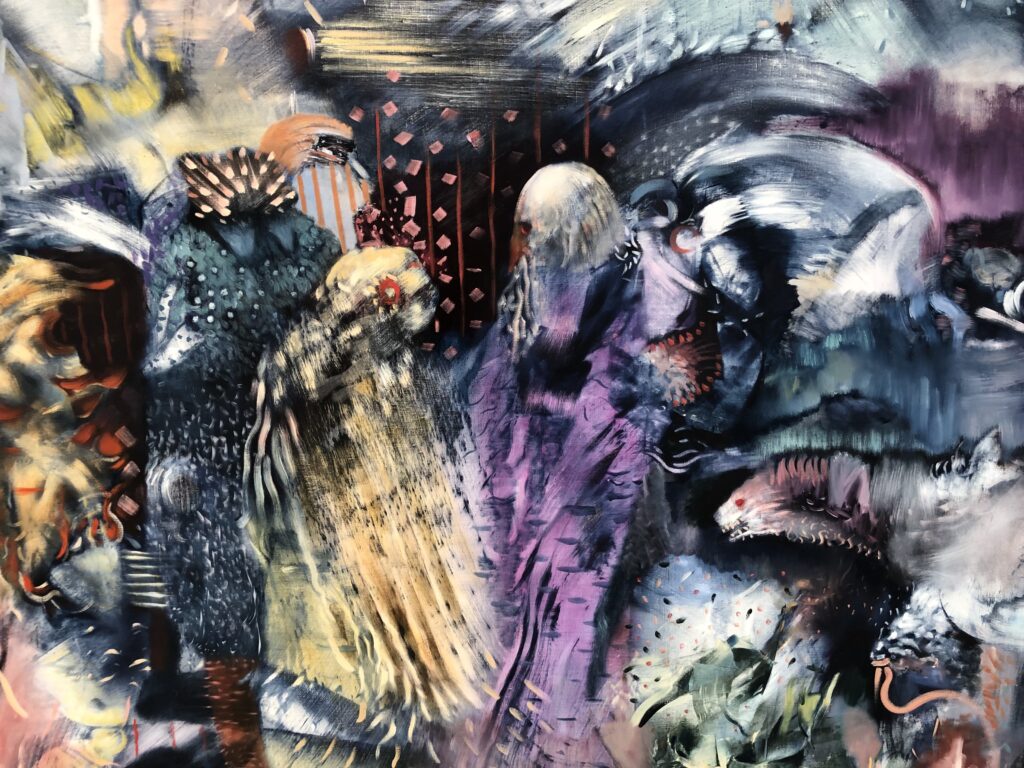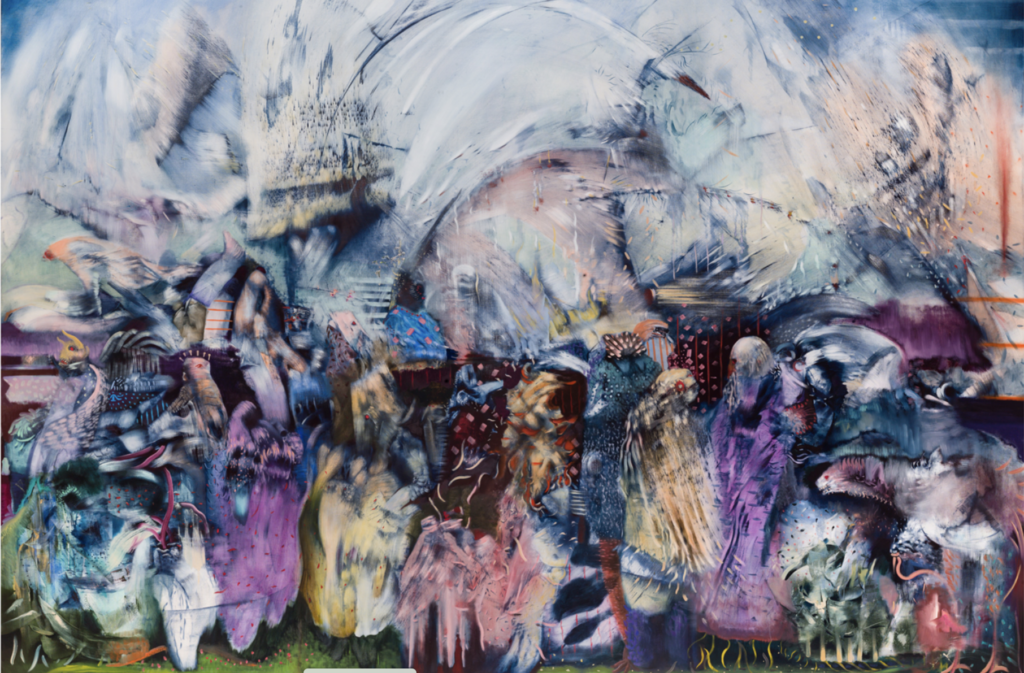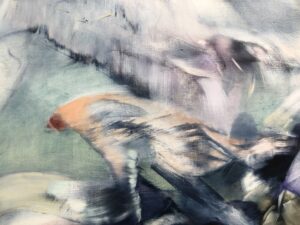Ali Banisadr’s dark, gestural menagerie

Detail from The Healers, Ali Banisadr, oil on linen
After a year and a half of not having crossed a bridge or driven through a tunnel into Manhattan, the most impactful exhibit I saw on my quick tour of Chelsea and SoHo two weeks ago was Ali Banisadr’s work at Paul Kasmin on W. 27th. The Iran-born Brooklyn painter has found a way to tap into the period when European Surrealism morphed into American Abstract Expressionism, and by re-inhabiting that fertile sea change, he’s uncovered something exceedingly rich and strange. In a way, he’s put himself back into the same position as Arshile Gorky, halfway between the two movements, exploring missed opportunities that could have emerged then, using the fulcrum this gives him to create his own eerie and strangely riveting canvases that have more than a little in common with Gorky’s.
Banisadr paints slow-motion and silent battlegrounds or communities of unnatural creatures, the spiritual equivalent of a Star Wars cantina. They’re the sort of beings a feverish child fears or covets in the closet or under the bed at night, little exotic pet-like entities with no recognizable morphology. They don’t look fierce; but they don’t look innocent either. Soft maybe, but not cuddly. They’re too uncanny to completely trust, more like random mutations of a fantasy video game cast or some occult catalog of spirits. It’s as if Hieronymus Bosch had returned and found a new way to embody human impulses as creatures from a weird children’s storybook. Yet there’s none of the repellent suffering you see in Bosch; instead, everything is as quiet and lovely as life in a tropical fish tank under black lights.

The Healers
These scenes lure you with the pleasure of their silky transitions from one rich color to another, the energy of their execution, the velvety quality of the paint that looks as if the support itself is plush and black. Everything seems to emerge from that black ground. What you see at first is just the quality of the paint—smeared, speckled, striped, combed. Every gesturally-determined form gradually and softly folds into the adjacent form. But then, as he continues to add daubs, dots, hatches, lines and lobes, the faces and hands and tentacles and mouths become just barely visible, as if still camouflaged by all the mark-making. This unpremeditated zoo of hastily assembled

Dolphin-like form
life forms seems to have recognized a way to materialize itself through has handling of paint. Stylistically, Banisadr turns painting into a kind of seance. Some of these creatures are lovely: in The Healers, a dolphin or bird either swims or flies forward, a body the color of a Creamsicle, with a little beak-like face muted red against a pale emerald background. But these shapes could also just as well be nothing but an abstract juxtaposition of flowing, organic forms.
His feel for color is exceptional and gives a disquieting allure to all this gestural busy-ness. In some paintings, he integrates everything by indicating the sky in the top third of the canvas, usually, which he breaks up with lines that suggest masts or javelins or poles for an army’s standards. Farther down, the intricate undergrowth begins, the actual conflict or caravan or pilgrimage of all the transmogrified creatures who seem to adopt the areas of paint and claim a daub of pink for a hand, a thumbprint of purple for a hooded face. He’s developed a way of handling paint where he wants you to first see the path of his brush, or the marks left by a comb, or whatever other tool he’s dragging across the surface, and then begin to just barely recognize the sentient interlopers who have taken possession of the paint, with their glowing red eyes and marsupial silhouettes. The effect isn’t creepy exactly, but the otherworldly carnival makes all of these little spirit animals seem lost and purposeless, clueless, crammed together, not getting along, but maybe not looking for trouble. They just jostle one another, glowing and glaring into the dark crowd that gazes back with just as much suspended animation, breathing little candle flames. In other words, it’s a lot like Twitter. Kandinsky would have been fascinated by this work, these enormous and intricate Rorschach blots. They look like something he was capable of having painted, with their suggestions of an abstracted spiritual realm, if he’s gone more deeply into the way he handled paint early on rather than moving into the geometry of his mature style.
What’s evident here is the embrace of the end of art history, and the resultant freedom for individual artists to rely on techniques, styles, anything used in the past, but in the present context, as Arthur Danto outlined it. Banisadr has simply positioned himself back at a turning point, in the evolution of Surrealism to Abstract Expressionism and done something that could have been done eighty years ago, but now it’s fresh again, renewed, and personalized. He makes the tropes and methods and some of the motivations his own, and the result is original because it’s utterly personal. His idiosyncrasy is his originality. It’s why all representational art being done now, even in some adaptation of the styles of the Old Masters, represents new and contemporary work, just as interesting as anything done in any other mode. What’s interesting to me is how few people realize we’ve arrived at this unforeseen Promised Land for visual art. Banisadr certainly does.
Comments are currently closed.